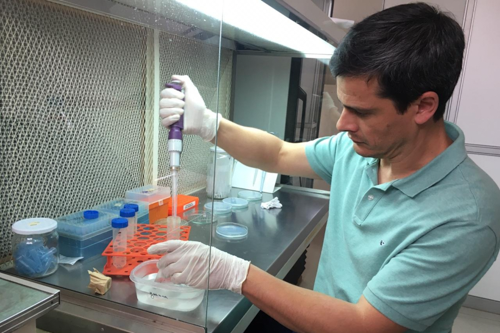Research Unearths Giant Fungal Viruses in the Crust
Viruses play an essential role in the ecology and evolution of microbial life in systems around the world. They’re found just about everywhere, even in the deep ocean crust far below the seafloor. Little is known, though, about the kinds of viruses that can be found there or which organisms they’re keen to infect.
What little work has been done confirmed that there is, indeed, a diverse community of viruses in the deep subsurface, and that those viruses appear to be actively infecting single-celled archaea and bacteria. But a team of researchers recently discovered evidence in the ocean crust of “giant” viruses, those with double-stranded DNA that can be several orders of magnitude larger than average, and found that they may actually be infecting fungi. That would make them the first viruses known to infect eukaryotic life in the deep subsurface. Their results open up a whole host of new questions on the role of viruses in biogeochemical cycling and evolution in the subsurface environment.
“We have these two giant viruses in an environment where we were not even expecting to find such big viruses, and we’re showing evidence that they might infect fungi, but they’re unlike any other known viruses of fungi” said Joaquín Martínez Martínez, a senior research scientist at Bigelow Laboratory for Ocean Sciences and co-author on the new study. “We might be seeing a really long evolutionary relationship that is unique to this environment.”
The results were published recently in the journal ISME Communications, led by Ananda Bhattacharjee, a former postdoctoral scientist at Bigelow Laboratory who is now an assistant project scientist at University of California, Riverside. In addition to Martínez Martínez, other co-authors on the paper include Vice President for Research Beth Orcutt and scientists from the U.S. Department of Energy Joint Genome Institute.
While viruses are perhaps best known for killing other organisms, they actually play a more nuanced role by altering the behavior of their hosts. They’re also a major driver of evolution. When a virus infects an organism, it can absorb little bits of that hosts’ genome and, at the same time, transfer a few of its own genes to the host. In that way, the virus can develop the ability to infect new species, while the host can evolve ways to protect itself from the virus or other viral particles. Thanks to that gene swap, viruses, end up with traces all of all the species they’ve infected literally encoded in their DNA – and vice versa.
That is how researchers on a 2017 study were able to deduce that viruses in the subsurface were actively infecting archaea and bacteria. They sequenced all the viral DNA in large samples of water drawn from several hundred meters deep in the ocean floor at the Juan de Fuca Ridge, the largest hydrologically active aquifer on Earth.
Martínez Martínez had water from the same cruise as the 2017 study – but only one milliliter.
Necessity, though, often drives innovation, and Martínez Martínez used his small sample to try out a new approach to study the viral community. Rather than filtering out larger cells and then sequencing all of the viral-like particles in one sizable sample, he instead sorted out individual viral particles that could be independently sequenced. The risk of stray DNA contaminating the sample was a lot higher with the approach, but so was the reward.
The team was able to identify two giant viruses that would have been filtered out among larger cells using traditional approaches. They were also able to find traces within their genomes of eukaryotic, archaeal, and bacterial DNA. The evidence suggested that these viruses likely infect fungi while also somehow interacting with other deep-subsurface microbes. Fungi are the most common form of eukaryotic life in the subsurface and are known to form their own symbiotic relationships with archaea and bacteria. The team’s discovery illuminates the potentially important ecological role of viruses, and their interactions with fungi, in this poorly understood ecosystem.
The results were so surprising, Martínez Martínez said he sequenced each sample twice just to be sure.
“We wanted to try something that would give me more information on what the viruses in that environment are actually doing, even if it didn’t show the full diversity of what’s down there,” said Martínez Martínez. “By coming up with a novel approach, we were able to open a door that we didn’t even know was there before.”

